Plays are meant to be staged. At least that’s what a playwright expects when he or she writes a play. A play or drama finds its fullest expression through the interpretations of its director and the actors. So what good is it to publish a book of plays? Mostly people who produce, direct and act in plays are typically interested in the text of the play and hence would likely be interested in a book of plays. Although it is true that some non-theater people do love to read plays just as much as some like to read stories and novels, but isn’t such a group a minority? Is it worth publishing a book for such a limited audience? These were the questions I was grappling with before I decided to go for a publication of an anthology of my plays. Continue reading
Category Archives: Cartoons
NABC 2010: Sahaj-Ma and Utpal Faqir
 Few months ago, I wrote my wish list about the kind of performers I’d like to see at the 2010 NABC in Atlantic City, and the one artist I mentioned specifically was Sahaj-Ma. When NABC 2010 committee announced the name of their foreign performers, I was delighted to see Sahaj-Ma and Utpal-Faqir’s name on the list. I am not sure whether the committee members actually read my post and felt inspired to invite the duo, or whether it was a sheer co-incidence – I am glad and thankful to the decision makers for giving us a chance to watch these amazing performers on stage.
Few months ago, I wrote my wish list about the kind of performers I’d like to see at the 2010 NABC in Atlantic City, and the one artist I mentioned specifically was Sahaj-Ma. When NABC 2010 committee announced the name of their foreign performers, I was delighted to see Sahaj-Ma and Utpal-Faqir’s name on the list. I am not sure whether the committee members actually read my post and felt inspired to invite the duo, or whether it was a sheer co-incidence – I am glad and thankful to the decision makers for giving us a chance to watch these amazing performers on stage.
I heard Sahaj-Ma first on ETV-Bangla on a show called “Baranday Roddur” conducted by the famous Bangla Band Bhoomi. It was kind of a mix of a musical and talk show, and Sahaj-Ma mostly talked about her musical journey. She mentioned about her early training in classical music from her mother and then from Pundit M.R. Gautam and Srimati Sunanda Pattanaik. And when she performed, it was mesmerizing. She has a unique style and tonal quality that is very rare in a female Bengali singer. The next time I listened to her music was in another ETV-Bangla show, “Dada Didir Ganer Lorai”. In this show, whenever she went up to perform, it was almost magical. Although she mostly performs Baul and folk songs, but in this show she proved that she has mastery over all forms of Indian music. Continue reading
Cartoon of the Week 16: Healthcare Costs
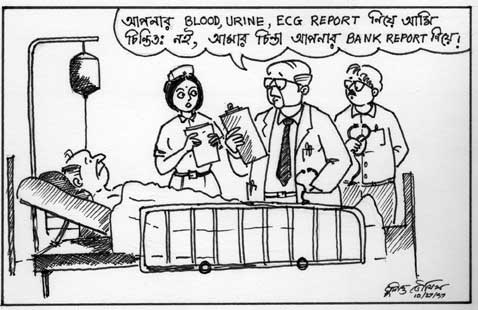
I drew this cartoon long time ago to highlight the healthcare cost crisis. For the benefit of the readers who don’t read Bengali let me explain it a bit. The doctor looking at his patient’s charts comments that he is not concerned with his lab reports but he is concerned about his bank statement reports which of course is not good enough to bear the cost of treatment.
Healthcare cost management, one of the major election issues last year, is once again in the back burner – being overshadowed by the economic meltdown. Although the recent economic stimulus package contains a provision to modernize health-care record keeping which can potentially reduce some of the costs and also provide for some computer programming jobs, it can hardly put a dent on this monstrous problem. Health-care cost is poised to be the next bubble to burst and it can also have devastating effects on the population and businesses. This needs to be dealt with as soon as possible before the entire system disintegrates. Many hospitals are reporting higher rates of ER admissions for patients without insurance. This is expected with the high unemployment numbers. Soon the hospitals will be asking for bail out money. Continue reading
Cartoon of the Week 15: Train Travel
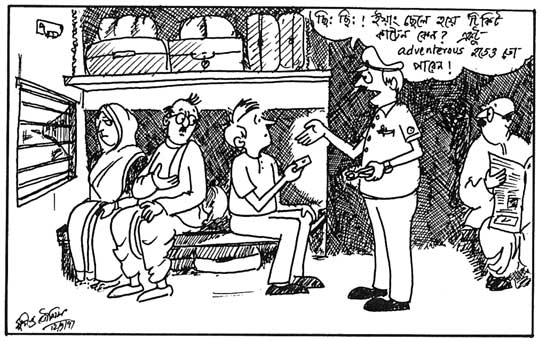 Traveling long distance by train was one of the most enjoyable modes of transportation in India. Once you get over the initial hurdles of getting a reserved seat or squeeze yourself in through the crowded doors as the train slowly rolls in to the platform or the frantic attempts to manage the porter and the family, the journey becomes much easy and enjoyable. Overnight train rides are especially thrilling when you not only need to manage a berth to sleep, but also keep an eye on your luggage and belongings to protect them from the “highly suspicious” co-passengers around you. When I was a child, I remember the train journeys from Kolkata (Sealdah or Howrah depending on which train you take) to Siliguri. Before the Farrakka bridge (barrage) was completed, we had to get off the train at Farakka and then take a steam boat across the Ganges to the other side (Sagrikoli Ghaat) and then scramble on to the train after a long run. If you were unlucky enough of not having a proper reservation, then your plight can only be imagined by those who took that journey. However, once you are settled in your seats or berths, temptations start knocking on your senses as the aroma of hot food attracts your attention along with the loud marketing attempts by the food vendors on the station. The appetizing offerings of “Ilish Maachher Jhol”, “Bhaaja Mooger Daal”, “Gorom Bhaat with Ghee” and “Begun Bhaja” pulls in many hungry passengers to the bamboo and hay thatched eateries all around the train station. Continue reading
Traveling long distance by train was one of the most enjoyable modes of transportation in India. Once you get over the initial hurdles of getting a reserved seat or squeeze yourself in through the crowded doors as the train slowly rolls in to the platform or the frantic attempts to manage the porter and the family, the journey becomes much easy and enjoyable. Overnight train rides are especially thrilling when you not only need to manage a berth to sleep, but also keep an eye on your luggage and belongings to protect them from the “highly suspicious” co-passengers around you. When I was a child, I remember the train journeys from Kolkata (Sealdah or Howrah depending on which train you take) to Siliguri. Before the Farrakka bridge (barrage) was completed, we had to get off the train at Farakka and then take a steam boat across the Ganges to the other side (Sagrikoli Ghaat) and then scramble on to the train after a long run. If you were unlucky enough of not having a proper reservation, then your plight can only be imagined by those who took that journey. However, once you are settled in your seats or berths, temptations start knocking on your senses as the aroma of hot food attracts your attention along with the loud marketing attempts by the food vendors on the station. The appetizing offerings of “Ilish Maachher Jhol”, “Bhaaja Mooger Daal”, “Gorom Bhaat with Ghee” and “Begun Bhaja” pulls in many hungry passengers to the bamboo and hay thatched eateries all around the train station. Continue reading
Cartoon of the Week 14: Buy and Return
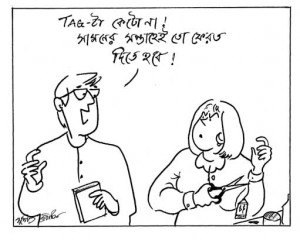 Last week the holiday shopping season kicked off with mad black Friday. With the current economic turmoil and officially declared recession looming on us, many pundits predicted that this shopping season will be less than stellar. However, the black Friday sales reports say something different. Shoppers flocked to the stores in hordes, many camped outside their favorite stores overnight. The tragic stampede death of a security worker at the Long Island Wal-mart clearly indicated the shopper frenzy was not at all dampened by any economic concerns. On the other hand, some may argue, that this shopper frenzy is caused due to the economic conditions since people want to spend the minimum this season. Hence black Friday was possibly their only option to get the best possible deals.
Last week the holiday shopping season kicked off with mad black Friday. With the current economic turmoil and officially declared recession looming on us, many pundits predicted that this shopping season will be less than stellar. However, the black Friday sales reports say something different. Shoppers flocked to the stores in hordes, many camped outside their favorite stores overnight. The tragic stampede death of a security worker at the Long Island Wal-mart clearly indicated the shopper frenzy was not at all dampened by any economic concerns. On the other hand, some may argue, that this shopper frenzy is caused due to the economic conditions since people want to spend the minimum this season. Hence black Friday was possibly their only option to get the best possible deals.
The other day I heard another pundit on the NPR who suggested that whatever disposable (now that’s a loaded word) income one makes this season, they should spend at the stores. This not only helps the economy, but also is the best use of the money at this moment since neither the stock market nor the bank can be relied upon. Hence enjoy while you can.
Another option may be to enjoy short term and return! The long return lines at the stores after the Christmas can be longer this season. After the instant gratification of shopping a fresh product, send it back to where it came from. Returning stuff is a hobby for many folks. They just buy stuff only to return them. The liberal return policy of these stores (who believe that the best way to satisfy a customer is to gladly accept the returned merchandise) have spoiled many a shopper. They love to return stuff, they seem to fall in love with the customer service counter as much as they love the cash counter. The only gripe they have is that they need to retain the price tags and the receipts. If only the tags could have been made invisible and the requirements for receipts waived – this world would have been heaven!
Cartoon of the Week 13: Prediction
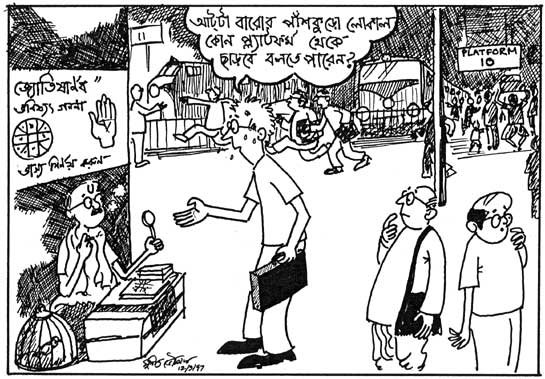
Many of us are strong believers in astrology and other similar practices like palmistry, tarot cards etc. etc. that claim to predict one’s future. A huge industry runs on servicing such people and also provides employment to millions. The television and other media advertisements of such sooth sayers and fortune tellers prove that they earn enough money to invest in these marketing campaigns. The precious and semi-precious gem stone market in India depends on the belief that the negative influence of the planets and stars can be countered by wearing a specific kind of gem stone that can cost thousands of rupees. Continue reading
Cartoon of the week 12: Culture Shock
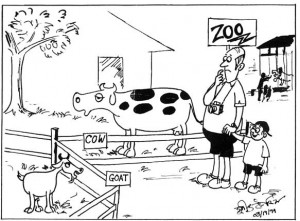 The other day I was at the Union County College (UCC) to participate in a seminar/talk about immigrant issues as portrayed in works of art and literature. The topic emerged from the works of Jhumpa Lahiri, since her two books, “Interpreter of Maladies” and “The Namesake”, are being selected as the college novels for the 2008-2009 term. After my talk, few of us were chatting regarding how we deal with cultural differences in our everyday life in this country. Each of us were narrating some incidents in our life and in connection to “The Namesake” we were talking about the significance of names in different cultures, how we address each other, and how they are being interpreted. Continue reading
The other day I was at the Union County College (UCC) to participate in a seminar/talk about immigrant issues as portrayed in works of art and literature. The topic emerged from the works of Jhumpa Lahiri, since her two books, “Interpreter of Maladies” and “The Namesake”, are being selected as the college novels for the 2008-2009 term. After my talk, few of us were chatting regarding how we deal with cultural differences in our everyday life in this country. Each of us were narrating some incidents in our life and in connection to “The Namesake” we were talking about the significance of names in different cultures, how we address each other, and how they are being interpreted. Continue reading
Cartoon of the Week 10: The Power of Salt
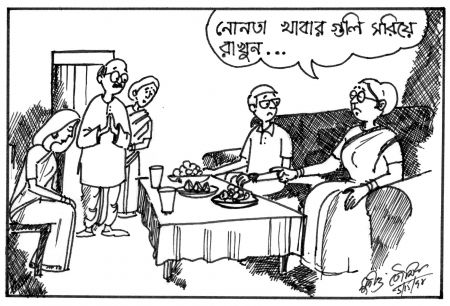 In the famous Bengali play “Alibaba” by Khirodprasad Bidyabinod, when the righteous dacoit chief came as a guest to Alibaba’s home – he mentioned about one diet restriction that he had – he doesn’t eat salt. Obviously his salt restriction was not because of hypertension or any other nephrological disease that he might have had (the playwright did not give any clues except that he was quite hot tempered). He didn’t want Alibaba to serve him any salty food because then he would have had to pay for his salt indebtedness. He would no longer be able to kill Alibaba and his family and loot back his wealth. He could never be a “Namak Haram”! Such is the power of salt. This mythological power of salt has been used as a test of ones righteousness. If you ever ingest salt served by somebody, you should always sing his praise – in Bengali we say “Noon khai jaar – Goon gai taar!” But these days we hardly obey such silly dictum. Continue reading
In the famous Bengali play “Alibaba” by Khirodprasad Bidyabinod, when the righteous dacoit chief came as a guest to Alibaba’s home – he mentioned about one diet restriction that he had – he doesn’t eat salt. Obviously his salt restriction was not because of hypertension or any other nephrological disease that he might have had (the playwright did not give any clues except that he was quite hot tempered). He didn’t want Alibaba to serve him any salty food because then he would have had to pay for his salt indebtedness. He would no longer be able to kill Alibaba and his family and loot back his wealth. He could never be a “Namak Haram”! Such is the power of salt. This mythological power of salt has been used as a test of ones righteousness. If you ever ingest salt served by somebody, you should always sing his praise – in Bengali we say “Noon khai jaar – Goon gai taar!” But these days we hardly obey such silly dictum. Continue reading
Cartoon of the Week 9: Are we Missing Something?
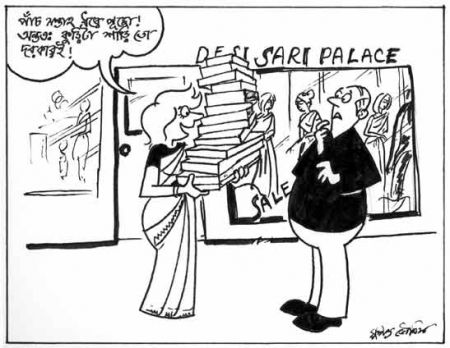 From the recent comments and postings on this and other blogs and from the “addas” at various Bijoya Sammilani parties, I keep on getting a constant message – maybe we are missing the good old style Durga Puja as it used to happen in this part of the world. We all can agree on one thing that back home, the Bijoya Dashami was one of the saddest day of the year. No amount of “Naru”, “Laddu” or “Ghugni” could sweep away the sadness. But when we came to this country, we discovered that Durga Puja does not have to end on one specific day. Continue reading
From the recent comments and postings on this and other blogs and from the “addas” at various Bijoya Sammilani parties, I keep on getting a constant message – maybe we are missing the good old style Durga Puja as it used to happen in this part of the world. We all can agree on one thing that back home, the Bijoya Dashami was one of the saddest day of the year. No amount of “Naru”, “Laddu” or “Ghugni” could sweep away the sadness. But when we came to this country, we discovered that Durga Puja does not have to end on one specific day. Continue reading
Cartoon of the Week 8: Puja Prasad
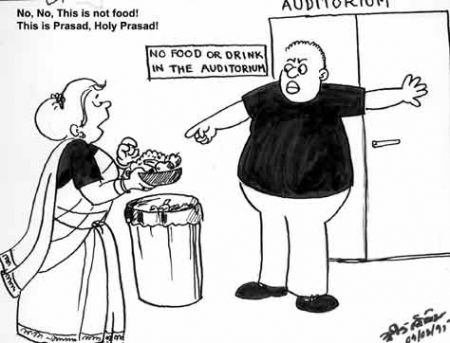 Finally, the Durga Puja festival is upon us. After all the registration/pre-registration dust settles, we’ll all assemble in front of Maa Durga and pray to give us a good life. We may be at different puja celebrations, but in some way, we all will be connected by the single thread of joy, hope and happiness that this festival has been bringing to us over the years.
Finally, the Durga Puja festival is upon us. After all the registration/pre-registration dust settles, we’ll all assemble in front of Maa Durga and pray to give us a good life. We may be at different puja celebrations, but in some way, we all will be connected by the single thread of joy, hope and happiness that this festival has been bringing to us over the years.
One of the most enjoyable things at the Durga Puja festivals is the community dinner. Sitting together and having a nice meal with the rest of the community gives a great feeling of solidarity. But these dinners are also a source of major logistical issues. Continue reading
